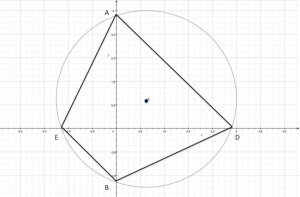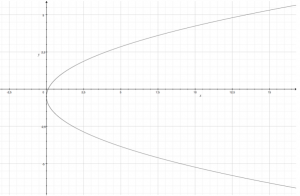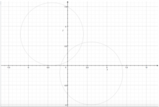Nella famiglia F di circonferenze di equazione:
[math]2 x^2 + 2 y^2 + 2ax + 2by + 4a + 3b = 0 [/math]
determinare quella il cui centro C appartiene alla bisettrice del 1°e del 3° quadrante e che passa per [math]P(1;-2)[/math]
e l'area e il perimetro del quadrilatero convesso ottenuto congiungendo i punti di intersezione della circonferenza con gli assi coordinati.
Determinare inoltre:
- l'equazione della parabola avente il vertice V sull'asse y e passante per P e C;
- sull'arco di parabola situato nel 4° quadrante un punto S in modo che risulti:
[math] \bar {SH} + \bar{SK} = \bar{CP}[/math]
, essendo [math] \bar {SH}[/math]
e [math] \bar {SK}[/math]
le distanze di S dagli assi x e y.
Risoluzione (0)
Sapendo che il centro della circonferenza appartiene alla bisettrice del 1° e del 3° quadrante, cioè a
[math] y = x[/math]
, sappiamo che le sue coordinate sono uguali.
Possiamo quindi scrivere che:
[math] C ( - a/2 ; - a/2 )[/math]
Poiché
[math] - a/2 = - b/2[/math]
, possiamo affermare che a=b. In questo caso l'equazione della circonferenza diventa:
[math] 2x^2 + 2y^2 + 2ax + 2ay + 4a + 3a = 0 [/math]
[math]2 x^2 + 2 y^2 + 2ax + 2ay + 7a = 0 [/math]
Dividiamo tutto per 2:
[math] x^2 + y^2 + ax + ay + 7/2 a = 0 [/math]
Determiniamo ora il valore del raggio utilizzando la formula
[math] r = \sqrt{(a/2)^2 + (b/2)^2 - c } [/math]
, che nel nostro caso diventa:
[math] r = \sqrt{(a/2)^2 + (a/2)^2 - c } = \sqrt(2 (a/2)^2 - c ) = \sqrt(2 \cdot (a^4)/4 - c ) = \sqrt((a^2)/2 - c ) [/math]
Sappiamo che la circonferenza passa per il punto P di coordinate (1;-2) e abbiamo le coordinate del suo centro
[math] C ( - a/2 ; - a/2 )[/math]
.
Possiamo trovare quindi il suo raggio calcolando la distanza fra i punti C e P:
[math] CP = \sqrt{(x_1 - x_2)^2 + (y_1 - y_2)^2} = \sqrt((1 + a/2)^2 + (-2 + a/2)^2) = [/math]
[math] \sqrt{1 + (a^2)/4 + a + 4 + (a^2)/4 - 2a} = \sqrt( (a^2)/2 - a + 5 ) [/math]
Possiamo ora eguagliare i due valori del raggio trovati:
[math] \sqrt{ (a^2)/2 - c } = \sqrt( (a^2)/2 - a + 5 ) [/math]
Eleviamo tutto al quadrato e risolviamo l'equazione:
[math] (a^2)/2 - c = (a^2)/2 - a + 5 [/math]
[math] - c = - a + 5 \to a - c = 5 [/math]
Considerando l'equazione della circonferenza [math] x^2 + y^2 + ax + ay + 7/2 a = 0 [/math]
, sappiamo che
[math] c = 7/2 a[/math]
, quindi:
[math] a - 7/2 a = 5 \to 2a - 7a = 10 \to a = -2 [/math]
Di conseguenza sappiamo che
[math] b = a = - 2[/math]
e che
[math] c = 7/2 a = 7/2 \cdot (-2) = - 7 [/math]
; l'equazione della circonferenza è quindi:
[math] x^2 + y^2 - 2x - 2y - 7 = 0 [/math]
Rappresentiamo la circonferenza nel piano cartesiano, sapendo che il suo centro è in C(1;1) e che il suo raggio misura 3:

Troviamo ora i suoi punti di intersezione con gli assi; cominciamo trovando l'intersezione con l'asse y:
[math] C â© x = 0 [/math]
[math][/math]
left{ \begin{array}{rl}
x = 0 &\
x^2 + y^2 - 2x - 2y - 7 = 0&
end{array}\right.
[math][/math]
[math][/math]
left{ \begin{array}{rl}
x = 0 &\
y^2 - 2y - 7 = 0&
end{array}\right.
[math][/math]
[math][/math]
left{ \begin{array}{rl}
x = 0 &\
y = frac{1 ± \sqrt{1 + 7}}{2} = frac{1 ± \sqrt(8)}{2} = frac{1 ± 2\sqrt(2)}{2} &
end{array}\right.
[math][/math]
Abbiamo quindi due punti, che chiamiamo A e B:
[math] A ( 0 ; 1 + 2\sqrt2 ) , B { 0 ; 1 - 2\sqrt2 } [/math]
Determiniamo ora le intersezioni con l'asse x:
[math] C â© y = 0 [/math]
[math][/math]
left{ \begin{array}{rl}
y = 0 &\
x^2 + y^2 - 2x - 2y - 7 = 0&
end{array}\right.
[math][/math]
[math][/math]
left{ \begin{array}{rl}
y = 0 &\
x^2 - 2x - 7 = 0&
end{array}\right.
[math][/math]
[math][/math]
left{ \begin{array}{rl}
x = 0 &\
x = frac{1 ± \sqrt{1 + 7}}{2} = frac{1 ± \sqrt(8)}{2} = frac{1 ± 2\sqrt(2)}{2} &
end{array}\right.
[math][/math]
Chiamiamo gli altri due punti D ed E:
[math] A ( 1 + 2\sqrt2 ; 0 ) , B {1 - 2\sqrt2 ; 0 } [/math]
Congiungiamo i punti:

Troviamo il perimetro del quadrilatero formatosi calcolando la distanza fra i punti A e D, D e B, B ed E, E ed A mediante la formula:
[math] d = \sqrt{(x_1 - x_2)^2 + (y_1 - y_2)^2} [/math]
[math] \bar{AC} = \sqrt{(0 - 1 - 2\sqrt2)^2 + (1 + 2\sqrt2 - 0)^2} = \sqrt((- 1 - 2\sqrt2)^2 + (1 + 2\sqrt2)^2) = [/math]
[math] \sqrt{1 + 8 + 4\sqrt2 + 1 + 8 + 4\sqrt2} = \sqrt(18 + 8\sqrt2) [/math]
Possiamo scomporre il risultato considerando che esso è un radicale doppio:
[math] \sqrt{a + \sqrt(b)} = \sqrt(frac(a + \sqrt(a^2 - b^2))(2)) + \sqrt(frac(a - \sqrt(a^2 - b^2))(2))[/math]
[math] \sqrt{18 + \sqrt(128)} = \sqrt(frac(18 + \sqrt(18^2 - (\sqrt(128))^2))(2)) + \sqrt(frac(18 - \sqrt(18^2 - (\sqrt(128))^2))(2)) = [/math]
[math] \sqrt{frac(18 + \sqrt(324 - 128))(2)} + \sqrt(frac(18 - \sqrt(324 - 128))(2)) = [/math]
[math] \sqrt{frac(18 + \sqrt(196))(2)} + \sqrt(frac(18 - \sqrt(196))(2)) = \sqrt(frac(18 + 14)(2)) + \sqrt(frac(18 - 14)(2)) = [/math]
[math] \sqrt{(32)/2} + \sqrt(4/2) = \sqrt(16) + \sqrt2 = 4 + \sqrt2 [/math]
Passiamo ora alla distanza DB:
[math] \bar{DB} = \sqrt{(0 - 1 - 2\sqrt2)^2 + (1 - 2\sqrt2 - 0)^2} = \sqrt((- 1 - 2\sqrt2)^2 + (1 - 2\sqrt2)^2) = [/math]
[math] \sqrt{1 + 8 + 4\sqrt2 + 1 + 8 - 4\sqrt2} = \sqrt(18) = 3 \sqrt2 [/math]
Calcoliamo BE:
[math] \bar{BE} = \sqrt{(0 - 1 + 2\sqrt2)^2 + (1 - 2\sqrt2 - 0)^2} = \sqrt((- 1 + 2\sqrt2)^2 + (1 - 2\sqrt2)^2) = [/math]
[math] \sqrt{1 + 8 - 4\sqrt2 + 1 + 8 - 4\sqrt2} = \sqrt(18 - 8\sqrt2) [/math]
Come prima, scomponiamo il radicale doppio:
[math] \sqrt{a - \sqrt(b)} = \sqrt(frac(a + \sqrt(a^2 - b^2))(2)) - \sqrt(frac(a - \sqrt(a^2 - b^2))(2))[/math]
[math] \sqrt{18 - \sqrt(128)} = \sqrt(frac(18 + \sqrt(18^2 - (\sqrt(128))^2))(2)) - \sqrt(frac(18 - \sqrt(18^2 - (\sqrt(128))^2))(2)) = [/math]
[math] \sqrt{frac(18 + \sqrt(324 - 128))(2)} - \sqrt(frac(18 - \sqrt(324 - 128))(2)) = [/math]
[math] \sqrt{frac(18 + \sqrt(196))(2)} - \sqrt(frac(18 - \sqrt(196))(2)) = \sqrt(frac(18 + 14)(2)) - \sqrt(frac(18 - 14)(2)) = [/math]
[math] \sqrt{(32)/2} - \sqrt(4/2) = \sqrt(16) - \sqrt2 = 4 - \sqrt2 [/math]
Infine calcoliamo EA:
[math] \bar{EA} = \sqrt{(0 - 1 + 2\sqrt2)^2 + (1 + 2\sqrt2 - 0)^2} = \sqrt((- 1 + 2\sqrt2)^2 + (1 + 2\sqrt2)^2) = [/math]
[math] \sqrt{1 + 8 - 4\sqrt2 + 1 + 8 + 4\sqrt2} = \sqrt(18) = 3 \sqrt2 [/math]
Notiamo quindi che due dei lati del quadrilatero sono uguali, in particolare
[math] \bar{EA} = \bar{DB} [/math]
; verifichiamo che
[math] \bar{AD} /// \bar{EB} [/math]
calcolando i coefficienti angolari delle due rette:
[math] m = frac(y_2 - y_1)(x_2 - x_1)[/math]
[math] m_(AD) = frac(0 - 1 - 2\sqrt2){1 + 2\sqrt2 - 0} = frac (- 1 - 2\sqrt2)(1 + 2\sqrt2) = [/math]
[math] - frac(+ 1 + 2\sqrt2){1 + 2\sqrt2} = -1 [/math]
[math] m_(AD) = frac(0 - 1 + 2\sqrt2){1 - 2\sqrt2 - 0} = frac (- 1 + 2\sqrt2)(1 - 2\sqrt2) = [/math]
[math] - frac(+ 1 - 2\sqrt2){1 - 2\sqrt2} = -1 [/math]
Possiamo affermare, quindi, che il quadrilatero in questione è un trapezio isoscele.
Determiniamo il suo perimetro:
[math] P = \bar{AD} + \bar{DB} + \bar{BE} + \bar{EA} = 4 + \sqrt2 + 3\sqrt2 + 4 - \sqrt2 + 3\sqrt2 = 8 + 6\sqrt2 [/math]
Per calcolare la sua area dobbiamo conoscere la sua altezza, cioè la distanza del punto B dalla retta AD.
Troviamo l'equazione della retta AD:
[math] AD: frac(x - x_1)(x_2 - x_1) = frac(y - y_1)(y_2 - y_1)[/math]
[math] AD: frac(x - 0)(1 + 2\sqrt2 - 0) = frac{y - 1 - 2\sqrt2}(0 - 1 - 2\sqrt2)[/math]
[math] AD: frac(x)(1 + 2\sqrt2) = frac{ - y + 1 + 2\sqrt2}(1 + 2\sqrt2)[/math]
[math] AD : x = - y + 1 + 2\sqrt2 \to AD : x + y - 1 - 2\sqrt2 = 0 [/math]
Calcoliamo la distanza del punto
[math] B ( 0 ; 1 - 2\sqrt2) [/math]
dalla retta AD:
[math] d = frac(| ax_0 + by_0 + c |)(\sqrt{a^2 + b^2})[/math]
[math] d(b ; AD) = frac(| 1 \cdot 0 + 1 \cdot (1 - 2\sqrt2) - 1 -2\sqrt2 |){\sqrt(1^2 + 1^2)} = [/math]
[math] frac(| 1 - 2\sqrt2 - 1 -2\sqrt2 |){\sqrt(1^2 + 1^2)} = frac(| -4 \sqrt2 |)(\sqrt2) = frac(4 \sqrt2)(\sqrt2)= 4 [/math]
Sapendo che l'altezza del trapezio vale 4, possiamo calcolare la sua area:
[math] A = frac(\bar{AD} + \bar{EB})(2) \cdot h = = frac(4 + \sqrt2 + 4 - \sqrt2){2} \cdot 4 = 8/2 \cdot 4 = 4 \cdot 4 = 16 [/math]
Risoluzione (1)
Sappiamo che a parabola passa per i punti C e P; possiamo quindi escludere che il suo asse sia parallelo all'asse y.
La sua equazione sarà quindi:
[math] x = ay^2 + by + c [/math]
e il suo vertice di coordinate
[math] (- frac(Î)(4a) ; - b/(2a)) [/math]
Imponiamo quindi il passaggio per i due punti:
[math] C (1 ; 1) \to 1 = a + b + c [/math]
[math] P (1 ; -2) \to 1 = 4a - 2b + c [/math]
Poiché il vertice della parabola appartiene all'asse y, sappiamo che
[math]- frac(Î)(4a) = 0[/math]
, quindi :
[math] - frac(b^2 - 4ac = 0)(4a) = 0 \to b^2 - 4ac = 0 [/math]
Mettiamo a sistema le tre scritture:
[math][/math]
left{
egin{array}{ll}
a + b + c = 1&\
4a - 2b + c = 1&\
b^2 - 4ac = 0 &
end{array}
ight.
[math][/math]
Risolviamo per sottrazione le prime due equazioni:
[math]a + b + c = 1[/math]
[math]-4a + 2b - c = - 1[/math]
[math]__________[/math]
[math]-3a + 3b = 0 \to - a + b = 0 \to a = b [/math]
Sostituiamo questa uguaglianza ad una delle prime equazioni e alla terza:
[math][/math]
left{ \begin{array}{rl}
a + a + c = 1 &\
a^2 - 4ac = 0&
end{array}\right.
[math][/math]
[math][/math]
left{ \begin{array}{rl}
2a + c = 1 &\
a^2 - 4ac = 0&
end{array}\right.
[math][/math]
Ricaviamo C dalla prima equazione e risolviamo per sostituzione:
[math][/math]
left{ \begin{array}{rl}
c = 1 - 2a &\
a^2 - 4ac = 0&
end{array}\right.
[math][/math]
[math][/math]
left{ \begin{array}{rl}
c = 1 - 2a &\
a^2 - 4a (1 - 2a) = 0&
end{array}\right.
[math][/math]
[math][/math]
left{ \begin{array}{rl}
c = 1 - 2a &\
a^2 - 4a + 8 a^2 = 0&
end{array}\right.
[math][/math]
[math][/math]
left{ \begin{array}{rl}
c = 1 - 2a &\
9 a^2 - 4a = 0&
end{array}\right.
[math][/math]
[math][/math]
left{ \begin{array}{rl}
c = 1 - 2a &\
a ( 9a - 4) = 0&
end{array}\right.
[math][/math]
[math][/math]
left{ \begin{array}{rl}
c = 1 - 2a &\
a = 0 ⨠a = frac{4}{9} &
end{array}\right.
[math][/math]
Dobbiamo escludere il caso in cui a sia uguale a zero, altrimenti l'equazione non rappresenterebbe una parabola;
[math][/math]
left{ \begin{array}{rl}
c = 1 - 2 * 4/9 = 1/9 &\
a = frac{4}{9} , b = frac{4}{9} &
end{array}\right.
[math][/math]
Possiamo scrivere l'equazione della parabola:
[math] x = 4/9 y^2 + 4/9 y + 1/9 [/math]
Rappresentiamo la parabola sul piano cartesiano tenendo presente che il suo vertice è di coordinate
[math] V ( 0 ; - b/(2a)) [/math]
, cioè
[math] V (0 ; - 1/2) [/math]

Risoluzione (2)
Prendiamo sull'arco di parabola situato nel 4° quadrante un punto S in modo che
[math] \bar{SH} + \bar{SK} = \bar{CP}[/math]

Sapendo che il punto S appartiene alla parabola, possiamo indicare le sue coordinate in questo modo:
[math] S ( 4/9 y^2 + 4/9 y + 1/9 ; y) [/math]
Calcoliamo la distanza fra il punto C(1;1) e il punto P(1;-2), considerando che essi appartengono alla stessa retta:
[math] \bar{CP} = 1 - (-2) = 3 [/math]
Allo stesso modo possiamo calcolare le distanze di S dagli assi, sottraendo la coordinata più piccola a quella più grande:
[math] \bar{SH} = y_H - y_S = 0 - y = - y[/math]
[math] \bar{SK} = x_S - x_K = 4/9 y^2 + 4/9 y + 1/9 - 0 = 4/9 y^2 + 4/9 y + 1/9 [/math]
Impostiamo ora l'equazione:
[math] - y + 4/9 y^2 + 4/9 y + 1/9 = 3 [/math]
[math] - 9 y + 4 y^2 + 4 y + 1 = 27 [/math]
[math] 4 y^2 - 5 y - 26 = 0 [/math]
[math] y = frac(5 ± \sqrt{25 + 4 \cdot 4 \cdot 26})(4 \cdot 2) = frac(5 ± \sqrt(25 + 416))(8) = [/math]
[math] frac(5 ± \sqrt{441})(8) = frac(5 ± 21)(8) [/math]
Dal momento che il punto P deve essere posto nel quarto quadrante, sappiamo che la sua ordinata è negativa; quindi escludiamo il risultato positivo.
[math] y = frac(5 - 21)(8) = - frac(16)(8) = - 2[/math]
[math] x_S = 4/9 \cdot (-2)^2 + 4/9 \cdot (-2) + 1/9 = 4/9 \cdot 4 - 4/9 \cdot 2 + 1/9 = [/math]
[math] (16)/9 - 8/9 + 1/9 = frac(16 - 8 + 1)(9) = 9/9 = 1[/math]
Di conseguenza, il punto S di coordinate (1;-2) coincide con il punto P.











 Accedi a tutti gli appunti
Accedi a tutti gli appunti
 Tutor AI: studia meglio e in meno tempo
Tutor AI: studia meglio e in meno tempo